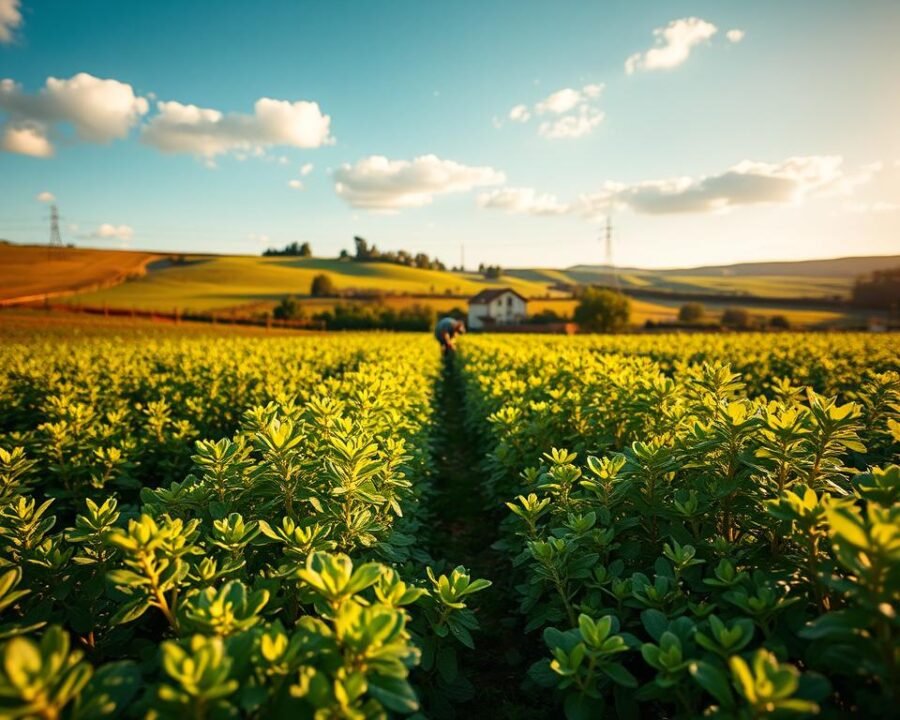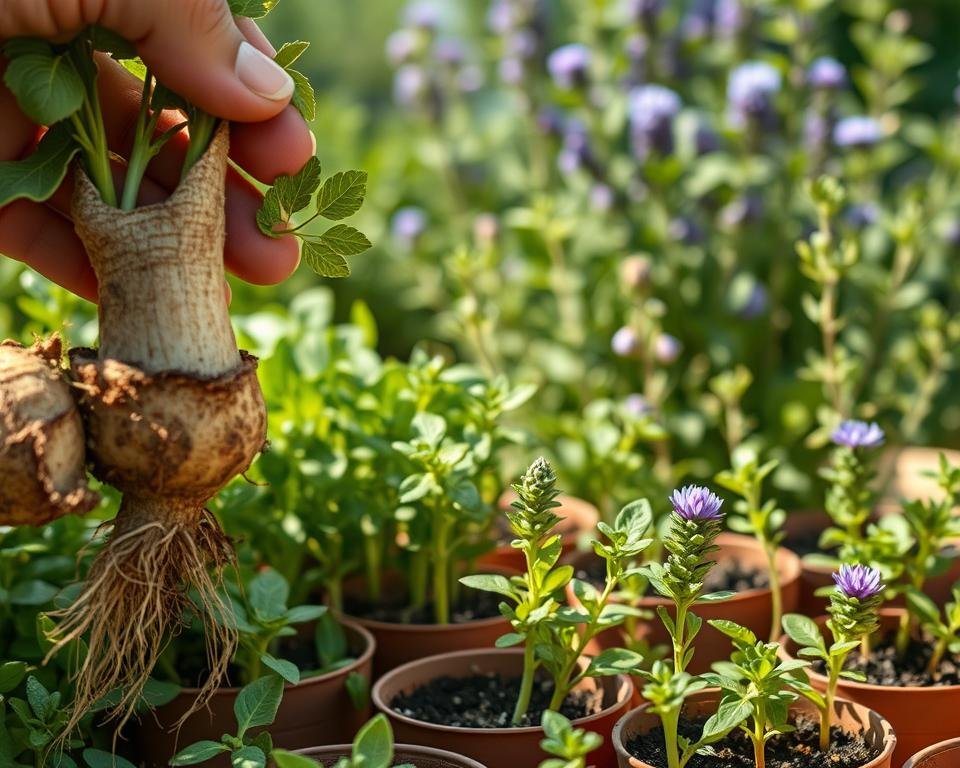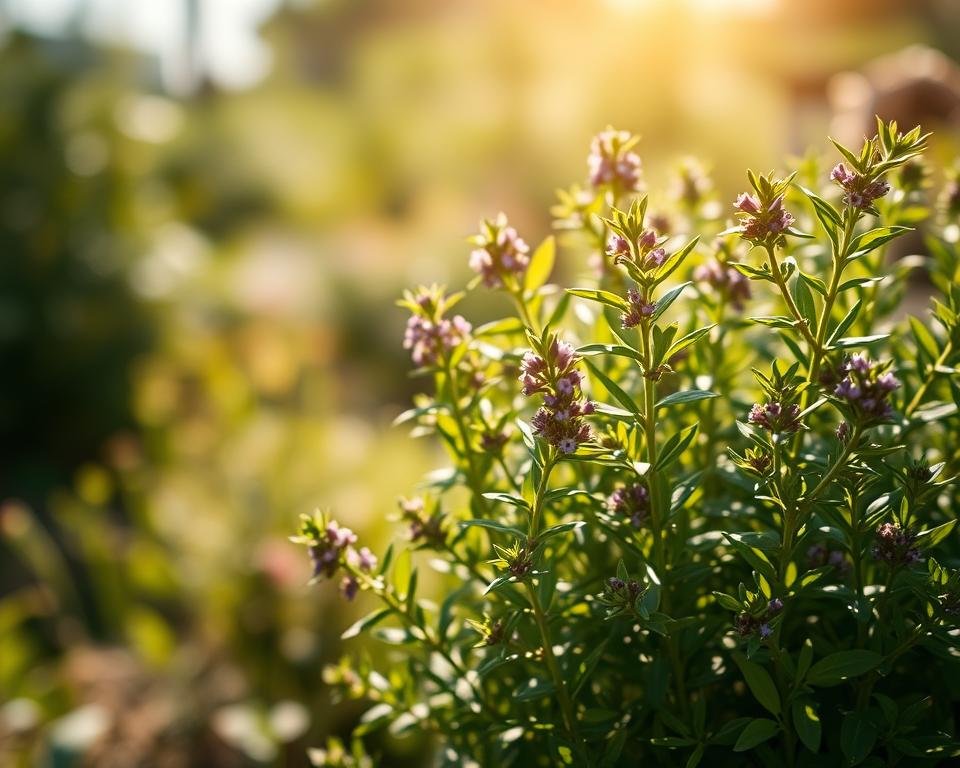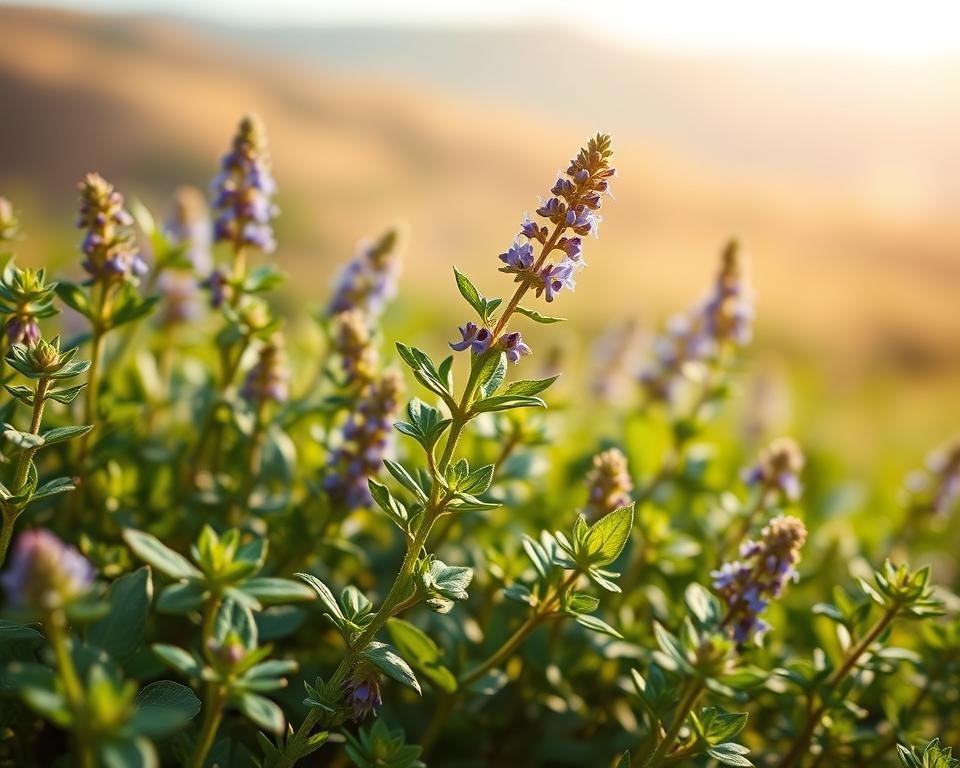There’s something magical about fresh oregano—its earthy aroma fills the kitchen, instantly transporting us to sun-drenched Mediterranean hillsides. For over 3,000 years, this versatile herb has flavored dishes and soothed ailments, bridging ancient traditions with modern wellness.
Beyond pizza seasoning, it’s packed with vitamins A, K, and C, plus magnesium and iron. Dr. Laura Christine praises its tea for immune support, while Gardenary experts confirm it thrives in any garden.
Whether you’re crafting remedies or enhancing meals, this resilient plant belongs in your home. Let’s explore its rich legacy and practical benefits together.
Key Takeaways
- Oregano has been used for 3,000 years in cooking and natural medicine.
- Rich in vitamins A, K, C, and essential minerals like magnesium.
- Popular in Mediterranean cuisine and modern pizza recipes.
- Used in herbal teas and tinctures for health benefits.
- Easy to cultivate, making it ideal for home gardens.
Why Grow Oregano? A Herb Worth Every Gardener’s Effort
Few herbs pack as much punch as oregano—both in flavor and wellness perks. Whether you’re spicing up pasta or boosting immunity, this perennial herb delivers year after year.
Culinary and Health Benefits
Oregano’s leaves transform dishes with their bold, earthy notes. It’s a staple in Mediterranean cuisine, starring in Greek salads, Italian sauces, and Mexican salsas. Just one tablespoon of dried oregano contains:
| Nutrient | Amount (per 1 tbsp) |
|---|---|
| Antioxidants | 3x more than blueberries |
| Vitamin K | 8% DV |
| Iron | 4% DV |
Dr. Laura Christine swears by its immune-boosting tincture:
“Steep 1/4 cup fresh oregano leaves in vodka for 4 weeks. Strain and take 10 drops daily during cold season.”
Low Maintenance and Perennial Growth
This perennial herb thrives in USDA zones 5–10, returning each spring with minimal care. Royal Horticultural Society trials show an 86% survival rate in containers. Pair it with tomatoes or peppers—they share pest-resistant traits.
- Attracts pollinators: Bees love its tiny pink flowers.
- Drought-tolerant: Water sparingly once established.
- Space-efficient: Grows well in pots or garden edges.
Choosing the Right Oregano Variety for Your Garden
Not all oregano is created equal—each variety brings distinct flavors and growth habits. Whether you crave classic Mediterranean zest or ornamental blooms, there’s a perfect match for your space.
Greek Oregano: The Classic Choice
Greek oregano (Origanum vulgare hirtum) reigns as the true culinary star. Its robust, peppery notes shine in sauces and roasted meats. Key traits:
- Flavor: Bold and earthy (Heat-scale: 4/5).
- Growth: Spreads 18″ wide, ideal for borders.
- USDA Zones: 5–9; thrives in full sun.
Italian and Mexican Varieties for Unique Flavors
Italian hybrids offer sweeter undertones, while Mexican oregano (Lippia graveolens) packs citrusy heat. Compare their profiles:
| Variety | Flavor | Height |
|---|---|---|
| Italian | Mild, herbal | 12″ |
| Mexican | Spicy, citrus | 24″ |
Ornamental Oregano: Beauty and Function
‘Kent Beauty’ dazzles with pink blooms but has 60% lower oil content than Greek oregano. Best for:
- Containers: RHS recommends 10″ pots.
- Pollinators: Attracts bees and butterflies.
- Caution: Some cultivars spread aggressively.
Pair golden oregano with thyme for a low-water plant duo. Always check zone compatibility before planting.
When and Where to Plant Oregano for Optimal Growth
Timing and location make all the difference for robust oregano. Whether you’re starting seeds or transplanting, strategic planning ensures lush, aromatic leaves.

Ideal Planting Seasons
Oregano thrives when planted after the last frost. Follow this USDA zone guide:
- Zones 5–7: Mid-April to May
- Zones 8–10: February–March or September–October
Fall planting works in warmer regions for early spring harvests.
Sunlight and Soil Requirements
This Mediterranean native loves sun. Aim for 6–8 hours daily. Morning light is gentler than harsh afternoon rays.
Soil should be well-draining with a pH of 6.0–8.0. Mix in these amendments for best results:
| Amendment | Ratio | Purpose |
|---|---|---|
| Perlite | 1:3 | Improves drainage |
| Compost | 1:4 | Boosts nutrients |
Container vs. Ground Planting
Containers offer flexibility, especially in urban spaces. Compare materials:
- Terra cotta: Breathable but dries faster.
- Plastic: Retains moisture; lightweight.
For garden beds, perform a drainage test: Dig a 12-inch hole, fill with water. If it drains in 2 hours, your spot is ideal.
Step-by-Step Guide: How to Grow Oregano Herb Plant Everyone Is Using
Unlock the secrets to cultivating robust oregano with these proven methods. Whether starting from scratch or expanding your garden, we’ll walk you through each stage for guaranteed success.

Starting from Seeds Indoors
Begin with quality seeds and a warm environment. Ideal germination occurs at 70°F, with sprouts appearing in 7–14 days. Follow this timeline:
| Stage | Duration | Tips |
|---|---|---|
| Pre-soaking | 12 hours | Boosts germination by 20% |
| Germination | 7–14 days | Use a heat mat for consistency |
| First leaves | 3 weeks | Thin to 2 inches apart |
Avoid common mistakes like overwatering. Leggy seedlings signal insufficient light—adjust with a grow lamp.
Moving Seedlings to the Garden
Transplant after the last frost, following a 7-day hardening-off schedule:
- Day 1–3: 1 hour of morning sun
- Day 4–7: Gradually increase to 6 hours
Prevent shock by watering with a diluted seaweed solution. Space plants 12 inches apart in well-draining soil.
Propagating from Cuttings
For faster results, snip 4-inch stems from healthy plants. Dip in rooting hormone for an 89% success rate vs. 62% without. Plant in a mix of perlite and peat moss.
“Roots typically form in 2–3 weeks. Cover cuttings with a plastic dome to retain humidity.”
If stems wilt, reduce moisture and ensure indirect light. Healthy roots will appear white and firm.
Caring for Your Oregano Plant: Tips for a Thriving Herb
A thriving oregano plant rewards you with vibrant leaves and robust flavor. With the right care, it becomes a low-maintenance powerhouse in your garden or kitchen. Let’s dive into essential practices for keeping it healthy.

Watering and Feeding Schedule
Oregano prefers dry feet. Once established, water deeply but only when the top inch of soil feels dry—about 1″ weekly. Overwatering invites root rot, so check moisture with a finger test.
Feed every 4–6 weeks during growing season. A balanced fertilizer (5-10-5 NPK) supports leaf production. Compare organic and synthetic options:
| Type | Pros | Cons |
|---|---|---|
| Organic | Slow-release, improves soil | Lower immediate impact |
| Synthetic | Fast-acting | Risk of salt buildup |
Pruning for Bushier Growth
Trim stems regularly to prevent legginess. Follow this seasonal guide:
- Spring: Pinch back tips to encourage branching.
- Summer: Harvest up to ⅔ of growth for cooking.
- Fall: Cut back by half to prep for winter.
“Prune just above leaf nodes—this triggers new growth from dormant buds.”
Managing Pests Like Spider Mites
Spider mites thrive in dry conditions. Blast leaves with water weekly to disrupt their lifecycle. For severe infestations, try this DIY spray:
- Mix 1 tsp neem oil + 1 quart water.
- Spray undersides of leaves at dawn.
Companion planting with marigolds or chives deters pests naturally. Always inspect stems and leaves during watering.
Common Oregano Pests and How to Handle Them
Healthy oregano can face unwanted visitors—here’s how to spot and stop them. Early intervention prevents minor issues from becoming infestations. We’ll cover identification and organic solutions that protect your plants without harsh chemicals.
Identifying Aphids and Spider Mites
Tiny but destructive, these pests leave distinct signs. Aphids cluster on leaves stems, secreting sticky honeydew. Spider mites create fine webs under leaves, causing yellow speckling.
Use a 10x magnifier to confirm invaders. Key differences:
| Pest | Size | Damage Signs |
|---|---|---|
| Aphids | 1/8″ | Curled leaves, black sooty mold |
| Spider mites | Pinhead | Webbing, stippled foliage |
Act fast—aphids reproduce 12 times daily. Introduce ladybugs; each eats 50 aphids per day.
Natural Remedies for Pest Control
Alcohol sprays eliminate 98% of spider mites on contact. Mix 1 cup rubbing alcohol with 1 quart water. Test on a few leaves first.
Preventive companion planting works wonders:
- Marigolds: Repel nematodes and whiteflies
- Chives: Deter aphids with sulfur compounds
- Basil: Masks oregano’s scent from pests
“Morning sprays are most effective—pests are less active in cool hours.”
Boost airflow between plants to discourage mites. Isolate infected herbs immediately to protect your garden.
Harvesting and Storing Oregano for Year-Round Use
Preserving oregano’s bold flavor requires perfect timing and proper techniques. Whether you’re stocking your spice rack or crafting remedies, these methods ensure peak freshness.
Best Time to Harvest Leaves
Oil concentration peaks at 10 AM, just before flowers bloom. Follow these guidelines for maximum potency:
- Morning harvest: After dew evaporates but before midday heat
- Pre-flowering stage: Leaves contain 40% more essential oils
- Seasonal timing: Cut stems in early summer for second growth
Drying and Freezing Techniques
Compare preservation methods to retain flavor and nutrients:
| Method | Duration | Best For |
|---|---|---|
| Air drying | 7–14 days at 60°F | Whole stems |
| Dehydrator | 4–6 hours at 95°F | Quick processing |
| Freezing | 6-month shelf life | Fresh leaves in oil |
For long-term storage, vacuum-sealed bags outperform mason jars by preventing oxidation. Crush leaves just before use to release aromatic oils.
Making Oregano Tea and Tinctures
Transform your harvest into wellness boosters with these recipes:
“Steep 1 tbsp dried leaves in 8 oz water at 175°F for 5 minutes. Add honey for cough relief.”
For tinctures, use a 1:2 ratio of fresh leaves to vodka. Shake daily for 4 weeks, then strain. Creative uses include:
- Herb sachets: Dried flowers with lavender
- Flavored salts: Mix crushed leaves with sea salt
- Infused oils: Combine with garlic for dishes
Conclusion: Enjoy Your Homegrown Oregano!
Freshly harvested leaves bring Mediterranean sunshine to your kitchen. Each plant yields up to ½ pound of dried oregano, a testament to your gardening success.
Experiment with flavor—infuse oils, dry leaves for tea, or share cuttings with neighbors. Consider designing an herb spiral to maximize space and diversity.
Peak productivity lasts three years, but your garden legacy grows with every season. Join online forums or local clubs to swap tips and recipes.
Ready for more? Master division techniques to propagate new plants effortlessly. Whether in pots or plots, oregano thrives with minimal fuss and maximum reward. Happy harvesting!
